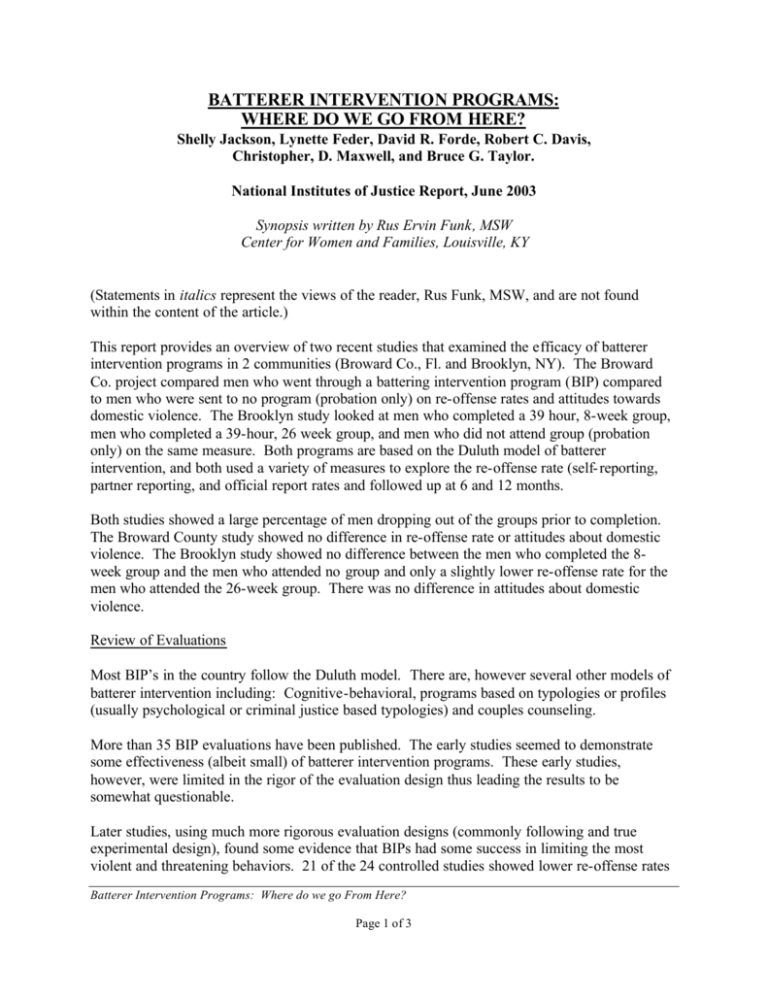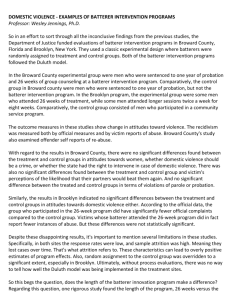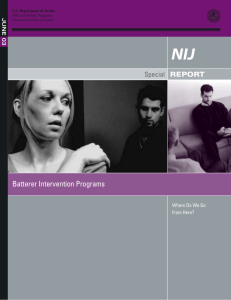Synopsis - National Center on Domestic and Sexual Violence
advertisement

BATTERER INTERVENTION PROGRAMS: WHERE DO WE GO FROM HERE? Shelly Jackson, Lynette Feder, David R. Forde, Robert C. Davis, Christopher, D. Maxwell, and Bruce G. Taylor. National Institutes of Justice Report, June 2003 Synopsis written by Rus Ervin Funk, MSW Center for Women and Families, Louisville, KY (Statements in italics represent the views of the reader, Rus Funk, MSW, and are not found within the content of the article.) This report provides an overview of two recent studies that examined the efficacy of batterer intervention programs in 2 communities (Broward Co., Fl. and Brooklyn, NY). The Broward Co. project compared men who went through a battering intervention program (BIP) compared to men who were sent to no program (probation only) on re-offense rates and attitudes towards domestic violence. The Brooklyn study looked at men who completed a 39 hour, 8-week group, men who completed a 39-hour, 26 week group, and men who did not attend group (probation only) on the same measure. Both programs are based on the Duluth model of batterer intervention, and both used a variety of measures to explore the re-offense rate (self- reporting, partner reporting, and official report rates and followed up at 6 and 12 months. Both studies showed a large percentage of men dropping out of the groups prior to completion. The Broward County study showed no difference in re-offense rate or attitudes about domestic violence. The Brooklyn study showed no difference between the men who completed the 8week group and the men who attended no group and only a slightly lower re-offense rate for the men who attended the 26-week group. There was no difference in attitudes about domestic violence. Review of Evaluations Most BIP’s in the country follow the Duluth model. There are, however several other models of batterer intervention including: Cognitive-behavioral, programs based on typologies or profiles (usually psychological or criminal justice based typologies) and couples counseling. More than 35 BIP evaluations have been published. The early studies seemed to demonstrate some effectiveness (albeit small) of batterer intervention programs. These early studies, however, were limited in the rigor of the evaluation design thus leading the results to be somewhat questionable. Later studies, using much more rigorous evaluation designs (commonly following and true experimental design), found some evidence that BIPs had some success in limiting the most violent and threatening behaviors. 21 of the 24 controlled studies showed lower re-offense rates Batterer Intervention Programs: Where do we go From Here? Page 1 of 3 than among control groups (although for few of these studies was this difference statistically significant). The Broward Co. Experiment An “N” of 404 men who were convicted of misdemeanor domestic violence were randomly assigned to either a control group (1 year probation), or a BIP (26-week group and 1 year probation). The men were mandated to treatment by the probation dept. The hypotheses of the study were 1) batterers mandated to treatment would be less likely to beat their partners than those assigned to the control group, and 2) men with a high stake in conformity would be less likely to beat their partners than those with low stake in conformity. 29% attended all sessions of the group, and 95% missed 5 or fewer sessions. 66% of the men attended all sessions. Outcome measures: Inventory of Beliefs About Wife-Beating and Attitudes toward Women, revised Conflict Tactics Scale (CTS2), victims’ reports and police reports. There was an 80% response rate for the men at the first interview, 50% at the second (6 months after adjudication). Victim’s response rates were 49% for the first interview, 30% for the second, and 22% for the last. The researchers fond no reason to believe that the control group and the men who attended the BIP differed in the amount or kind of monitoring, supervision and treatment from the probations officers. Findings Approximately ½ of the men viewed battering as acceptable in certain situations. There was no difference between the experimental and control groups initially and ove r time (meaning that the group did not create any improvement over time, or compared to the men who did not attend the group). Men who attended the group did show a slight but statistically significant decrease over time in the degree to which they held the women responsible for the abuse. They still, however, viewed their partners as “somewhat” to “equally” responsible for their abusiveness. The men who attended the group did not demonstrate any difference in self- reported likelihood to abuse again in the future. The women partners of the men did not differ in their view that their abusers behaviors should be seen as a crime (57%), or their perceptions of the likelihood that the men would hit them again. 24% of the men (both men who attended group and the men who did not) were re-arrested within one year. The Brooklyn Experiment Batterer’s were mandated to “treatment” by judicial order (as opposed to the Broward Co. study), and batterers were eligible for “treatment” only if all parties (prosecution, defense and judge) Batterer Intervention Programs: Where do we go From Here? Page 2 of 3 agreed that the BIP was appropriate. As such, the results are harder to generalize than the Broward Co. study. This study compares batterers assigned to a traditional 26-week group, assigned to a 8-week group (same number of hours, and both based on the Duluth model), and batterers assigned to community service. The experiment had an N of 376. Batterers and victims were interviewed at the court disposition, 6 months and 12 months follow up. 2 measures of batterer-victim violence: new reports to legal authorities, or victim reports of new incidents (thus if a batterer had a new relationship, there may not be a way to capture new abuse incidents). Findings Batterers were far more likely to complete the shorter group (67%) than the longer one (27%). Victim-reports that those who attended 26-week group committed fewer violent acts than those who attended 8 weeks or no “treatment” Those who completed the 26 week group went longer before battering again than those who completed 8 weeks or no “treatment.” “There is no basis for claiming that treatment changes batterers’ attitudes or ways of dealing with conflicts” (p. #19). “The results of this study do not support the view that treatment leads to lasing changes in behavior” (p. #20). Analyzing the Studies What does “success” mean – does this mean cessation of violence, or a reduction of violence? (it is worth noting that the NIJ’s definition excludes changes in attitudes although this was part of both of the studies suggesting that it was a goal of treatment) “BIP’s may be effective only in the context of broader criminal justice innovations” (p. #27). “Rather than asking whether BIP’s work, a more productive question may be which programs work best for which batterers under which circumstances” (p. #20). (Although given that no typology has been found to be an effective way to define different types of batterers, and that these research findings found that these programs re not successful with any particular group of men, this statements seems premature at best). Batterer Intervention Programs: Where do we go From Here? Page 3 of 3











